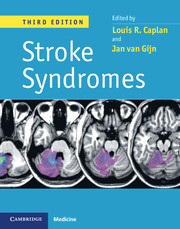Book contents
- Stroke Syndromes
- Stroke Syndromes
- Copyright page
- Contents
- Contributors
- Section 1 Clinical manifestations
- Section 2 Vascular topographic syndromes
- Chapter 29 Arterial territories of the human brain
- Chapter 30 Middle cerebral artery territory syndromes
- Chapter 31 Anterior cerebral artery
- Chapter 32 Anterior choroidal artery territory strokes
- Chapter 33 Thalamic infarcts and hemorrhages
- Chapter 34 Caudate nucleus infarcts and hemorrhages
- Chapter 35 Posterior cerebral artery
- Chapter 36 Space-occupying supratentorial and infratentorial ischemic stroke
- Chapter 37 Multiple and bihemispheric infarcts
- Chapter 38 Midbrain infarcts and hematomas
- Chapter 39 Pontine infarcts and hemorrhages
- Chapter 40 Medullary infarcts and hemorrhages
- Chapter 41 Cerebellar infarcts
- Chapter 42 Borderzone infarcts
- Chapter 43 The classical lacunar syndromes
- Chapter 44 Basal ganglionic hemorrhages
- Chapter 45 Lobar hemorrhages
- Chapter 46 Intraventricular hemorrhage
- Chapter 47 Subarachnoid hemorrhage syndromes
- Chapter 48 Cerebral venous thrombosis
- Chapter 49 Carotid occlusion syndromes
- Chapter 50 Cervical artery dissections
- Chapter 51 Intracranial arterial dissections
- Chapter 52 Syndromes related to large artery thromboembolism in the posterior circulation
- Chapter 53 Spinal stroke syndromes
- Index
- Plate Section (PDF Only)
Chapter 51 - Intracranial arterial dissections
from Section 2 - Vascular topographic syndromes
Published online by Cambridge University Press: 05 August 2012
- Stroke Syndromes
- Stroke Syndromes
- Copyright page
- Contents
- Contributors
- Section 1 Clinical manifestations
- Section 2 Vascular topographic syndromes
- Chapter 29 Arterial territories of the human brain
- Chapter 30 Middle cerebral artery territory syndromes
- Chapter 31 Anterior cerebral artery
- Chapter 32 Anterior choroidal artery territory strokes
- Chapter 33 Thalamic infarcts and hemorrhages
- Chapter 34 Caudate nucleus infarcts and hemorrhages
- Chapter 35 Posterior cerebral artery
- Chapter 36 Space-occupying supratentorial and infratentorial ischemic stroke
- Chapter 37 Multiple and bihemispheric infarcts
- Chapter 38 Midbrain infarcts and hematomas
- Chapter 39 Pontine infarcts and hemorrhages
- Chapter 40 Medullary infarcts and hemorrhages
- Chapter 41 Cerebellar infarcts
- Chapter 42 Borderzone infarcts
- Chapter 43 The classical lacunar syndromes
- Chapter 44 Basal ganglionic hemorrhages
- Chapter 45 Lobar hemorrhages
- Chapter 46 Intraventricular hemorrhage
- Chapter 47 Subarachnoid hemorrhage syndromes
- Chapter 48 Cerebral venous thrombosis
- Chapter 49 Carotid occlusion syndromes
- Chapter 50 Cervical artery dissections
- Chapter 51 Intracranial arterial dissections
- Chapter 52 Syndromes related to large artery thromboembolism in the posterior circulation
- Chapter 53 Spinal stroke syndromes
- Index
- Plate Section (PDF Only)
Summary
Keywords
- Type
- Chapter
- Information
- Stroke Syndromes, 3ed , pp. 566 - 573Publisher: Cambridge University PressPrint publication year: 2012
- 3
- Cited by



